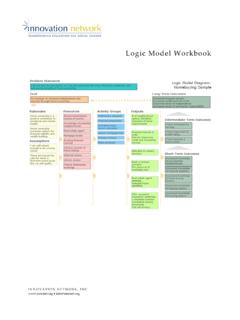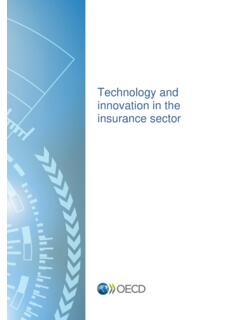Transcription of Business Models for the Circular Economy - OECD
1 Business Models for the Circular Economy Opportunities and Challenges from a Policy Perspective RE-CIRCLE POLICY HIGHLIGHTS. Resource Efficiency & Circular Economy Project Business Models for the Circular Economy Circular Business Models represent fundamentally different ways of producing and consuming goods and services. They have the potential to drive the transition towards a more resource efficient and Circular Economy and, in doing so, significantly reduce the environmental pressure resulting from economic activity. RE-CIRCLE. Resource Efficiency & Circular Economy Project Key messages Circular Business Models serve to reduce the extraction and use of natural resources and the generation of industrial and consumer wastes.
2 They represent the key activities required to transition to a more resource efficient and Circular Economy . Circular Business Models use already existing materials and products as inputs and therefore their environmental footprint tends to be considerably smaller than that for traditional Business Models . The environmental outcomes of Circular Business Models also depend on their market penetration. However, the market share of these Business Models is currently limited. Recycling, remanufacturing and repair, the sharing of spare capacity, and the provision of services rather than products typically only account for up to 15% of production in any given sector. Some Circular Business Models have experienced rapid growth in recent years, largely in response to the emergence of new technologies.
3 For instance, Airbnb has gone from being a curiosity in the accommodation sector ten years ago to being the largest single supplier of short term stays today. Most other Circular Business Models recycling and repair being good examples are relatively mature. In some cases, the emergence of enabling technologies, more supportive consumer preferences, or new Business risks will drive increased adoption of Circular Business Models . Public policy also has a role to play. In particular, governments could focus on addressing widely cited barriers such as: i. the mispricing of natural resources that results from under-priced externalities and the provision of subsidies for extractive sectors.
4 Ii. the transaction costs that hinder collaboration within and across value chains;. iii. the trade policies that restrict cross border flows of used products and secondary material feedstock, and;. iv. the status quo biases that are often inherent in investment and consumer behaviour. 1. Key characteristics of Circular Business Models Circular Business Models modify the pattern of product and material flows through the Economy . By doing so, they can reduce the adverse environmental side-effects resulting from the extraction, use, and eventual disposal of natural resources and materials. This results not only from facility level improvements in material productivity, but also from more fundamental changes in production and consumption patterns.
5 For example, instead of using natural resource inputs more efficiently, renewable energy generation and the production of raw materials from scrap do not use them at all. Five headline Business Models for a more Circular Economy : l Circular supply Models , by replacing traditional material inputs derived from virgin resources with bio-based, renewable, or recovered materials, reduce demand for virgin resource extraction in the long run l Resource recovery Models recycle waste into secondary raw materials, thereby diverting waste from final disposal while also displacing the extraction and processing of virgin natural resources l Product life extension Models extend the use period of existing products, slow the flow of constituent materials through the Economy , and reduce the rate of resource extraction and waste generation l Sharing Models facilitate the sharing of under-utilised products.
6 And can therefore reduce demand for new products and their embedded raw materials l Product service system Models , where services rather than products are marketed, improve incentives for green product design and more efficient product use, thereby promoting a more sparing use of natural resources. 4 . OECD POLICY HIGHLIGHTS Business Models for the Circular Economy Opportunities and Challenges from a Policy Perspective POLICY HIGHLIGHTS. Circular Business Models do not operate in isolation The distinction between different Circular Business Models is clear in theory, but may be less so in reality. In some cases, firms adopt combinations of Business Models . For example, the adoption of product service system model and the retention of a product ownership that goes with it may serve to incentivise the parallel adoption of product repair or remanufacturing.
7 In other cases, the decision to adopt a particular Circular Business model by a firm or group of firms can facilitate the adoption of a related Business model by others. Not all Circular Business Models are necessarily new Recycling, reuse, and repair have existed for millennia. The sharing of under-utilised household possessions also has a long history, and the provision of access to products, rather than ownership of them, is not so different from traditional product leasing. What is new is the growing diversity and sophistication of these Business Models , as well as the range of sectors they are adopted in. In the context of personal transport, vehicles containing a significant proportion of recycled materials or remanufactured parts are now available.
8 Alternatively, where access to mobility is preferred to ownership, ride sharing, car sharing, or short term car rental have become potential solutions. Figure 1. Circular Business Models operate in different parts of the value chain r ing ling a ctu c yc uf Re an e m Re -us pair Re Re g n . e ct sin io lif al a n ct os es uf of sig il tra sp ta an oc d e De En Re Us Ex Di Pr M. Renewable or bio-based Industrial Sharing inputs symbiosis Source: Adapted from Accenture (2015). OECD POLICY HIGHLIGHTS Business Models for the Circular Economy Opportunities and Challenges from a Policy Perspective. 5. 2 The environmental potential of Circular Business Models Circular Business Models , by closing resource loops and by slowing and narrowing resource flows, can reduce the environmental footprint of economic production and consumption.
9 These environmental benefits can be significant. In Although relatively little empirical data is available, the case of the resource recovery Business model , the sharing or leasing of already existing products also producing raw materials via recycling, rather than seems likely to lead to lower environmental burdens. from non-renewable natural resources, can reduce A switch from ownership to access creates a new set greenhouse gas emissions by as much as 90% (BIR, of incentives around product design, product use, 2008). The magnitude of emissions reductions and product disposal. For product manufacturers, involved varies across materials, but is significant in the retention of ownership can incentivise the design almost all cases (Figure 2).
10 Of products that are both relatively long-lasting, and more amenable to remanufacture or recycling at Other Circular Business Models also have considerable their end of life. For consumers, paying for the service environmental benefits. Remanufacturing products provided by the product, rather than the product itself, that have reached their end of life can reduce the can lead to behavioural changes. A number of studies extraction of natural resources and generation find that members of urban car sharing schemes of waste by up to 80% relative to manufacturing typically reduce their vehicle kilometres travelled by new products. Reduced extraction, processing, and 15-40%. transport of natural resources also translates into energy savings, often in excess of 50% (Table 1).












